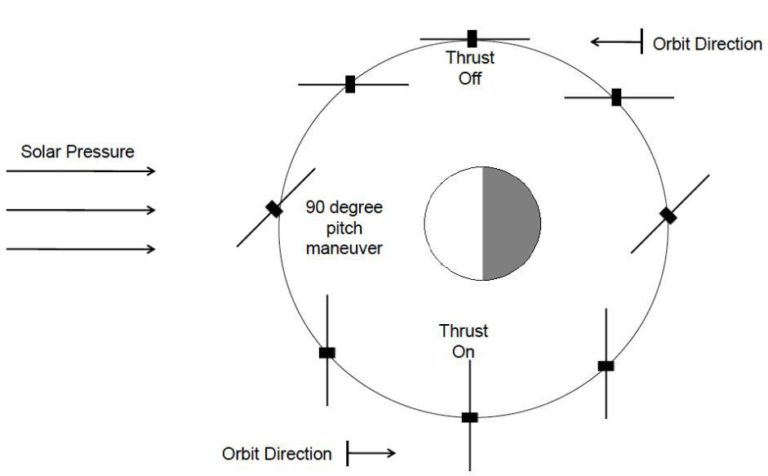Jason Davis • Jul 09, 2014
LightSail update: Launch dates
I’m excited to report some big news on The Planetary Society’s LightSail project: actual launch dates on actual launch vehicles!
In April 2016, LightSail 1 and its parent satellite, Prox-1, are scheduled to hitch a ride to orbit aboard SpaceX’s new Falcon Heavy rocket. LightSail 1 will be released into space, unfurl its silver sails and attempt to become the first CubeSat to demonstrate controlled solar sailing—flight by light.
Here’s a mission trailer. Josh Spradling, a talented visual effects artist, did a phenomenal job of animating LightSail 1 in orbit.
LightSail 1 Mission Trailer CubeSats are tiny, low-cost satellites that have opened up new avenues of space research for universities and small organizations. To help CubeSat applications reach the next level, The Planetary Society is testing an elegant propulsion method called solar sailing that could help CubeSats maneuver in Earth orbit and reach interplanetary destinations.
The LightSail announcement was made during a live webcast of Planetary Radio Wednesday evening at the KPCC Crawford Family Forum in Pasadena, Calif. Mat Kaplan emceed the event and was joined by Bill Nye and Jim Bell from The Planetary Society. From the LightSail team, project manager Doug Stetson and system engineer Barbara Plante discussed the ins and outs of the spacecraft and its mission. Science fiction author David Brin made a special appearance, and I also sneaked onstage for few minutes.
As I’ve previously discussed, LightSail 1 is the design designation for two nearly identical solar sailing CubeSats named LightSail 1 and LightSail 2. In May 2015, LightSail 1 may join a group of other ride-sharing spacecraft aboard an Air Force Atlas V flight as part of NASA’s Educational Launch of Nanosatellites (ELaNa) program. ELaNa helps CubeSat operators find rides to orbit.
The decision on whether or not to fly LightSail 1 will be based largely on systems tests that still lie ahead. If LightSail 1 goes to space, it won’t reach a high enough altitude for the momentum it gains from solar sailing to overcome atmospheric drag. The spacecraft will deploy its sails, capture images, and communicate with the ground, giving engineers a chance to work through any problems en route to a full-fledged solar sailing flight.
LightSail 2 is the big show. The CubeSat will be embedded inside another small satellite called Prox-1. Together, Prox-1 and LightSail 2 will ride into space aboard SpaceX’s Falcon Heavy launch vehicle. The mission is currently scheduled for April 2016.

Prox-1 is a technology demonstration for using small satellites to autonomously inspect other spacecraft. David Spencer, the project’s principal investigator at the Georgia Institute of Technology, told me one potential application could involve a capsule full of astronauts.
"Think of the Orion spacecraft," he said, referring to NASA's future crew vehicle. "It would be very nice to have a robotic service vehicle that could go out and look for micrometeoroid impacts on the crew capsule and make sure that it's ready for Earth return."
Prox-1 and LightSail 2 will be released into a circular orbit with an altitude of 720 kilometers (450 miles). After spending a couple weeks going through various checkouts, Prox-1 will release LightSail 2. Prox-1 will then rendezvous with LightSail 2 using a thermal imaging camera for navigation, flying as close as 50 meters.
Prox-1 Concept of Operations This concept of operations animation shows the Prox-1 spacecraft deploying and imaging LightSail 2 in Earth orbit. Prox-1 is a mission to demonstrate automated trajectory control relative to a CubeSat in low-Earth orbit. The spacecraft is being developed by the Georgia Institute of Technology.Video: Georgia Institute of Technology
After that, LightSail 2 will be given the go-ahead to release its solar sails. "If all goes well,” Spencer said, “Prox-1 will be there to take some pretty stunning images of the solar sail." Prox-1’s images will accompany a series taken by LightSail 2’s onboard cameras.
LightSail 2 will then attempt to increase its velocity using nothing but sunlight. As it turns perpendicular to the sun’s rays, photons will strike the sail, transferring momentum to the spacecraft. The general concept looks like this:

If the LightSail project is successful, it will demonstrate a viable method of propulsion for CubeSats. I asked Barbara Plante why CubeSats don’t come equipped with miniature fuel tanks and thrusters. She said the nature of ride-sharing makes CubeSats carrying propellant an unattractive proposition for many satellite operators.
“The problem is that when CubeSats are on ride-along missions, people who have half-a-billion dollar payloads or even hundred million dollar payloads don’t want CubeSats with propulsion riding along,” Plante said. She added that some companies are indeed attempting to develop low-risk propulsion systems for CubeSats. However, the advantage of solar sailing is that it creates a way to harness the sun’s unlimited energy. The thrust is also continuous, meaning CubeSats with solar sails could eventually be spiraled out of Earth orbit altogether and sent on interplanetary journeys.
For The Planetary Society, LightSail marks the culmination of a decades-long effort to fly a solar sailing spacecraft. Nine years ago, the Society’s ambitious Cosmos 1 spacecraft launched from a Russian submarine beneath the Barents Sea aboard a converted ballistic missile. Sadly, the rocket’s engine flamed out prematurely, sending the entire 4 million dollar payload back into the sea.
It was a crushing end to a promising project for both The Planetary Society and the project’s sponsor, Cosmos Studios. But just a few months later, then-Planetary Society director Louis Friedman was rallying support to try again.
If Cosmos-1 had flown, it would have been the world’s first spacecraft to fly on light. Instead, the honor instead went to Japan’s IKAROS, which was launched with the Venus Climate Orbiter in 2010. That same year, NASA’s NanoSail-D deployed the first CubeSat solar sail in Earth orbit. Another upcoming NASA effort called Sunjammer will attempt to deploy a solar sail with a whopping area of 1200 square meters (13,000 square feet).
LightSail 1’s niche is providing flight by light for much smaller satellites. Could we eventually see a fleet of solar sailing CubeSats heading to the L1 point, or to interplanetary destinations like Mars? It’s certainly a possibility.

Let’s Go Beyond The Horizon
Every success in space exploration is the result of the community of space enthusiasts, like you, who believe it is important. You can help usher in the next great era of space exploration with your gift today.
Donate Today

 Explore Worlds
Explore Worlds Find Life
Find Life Defend Earth
Defend Earth

